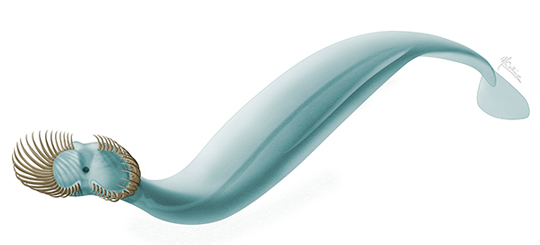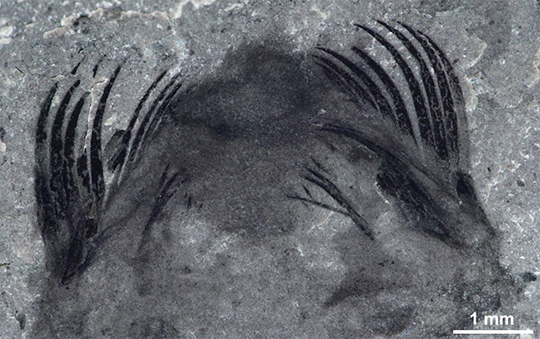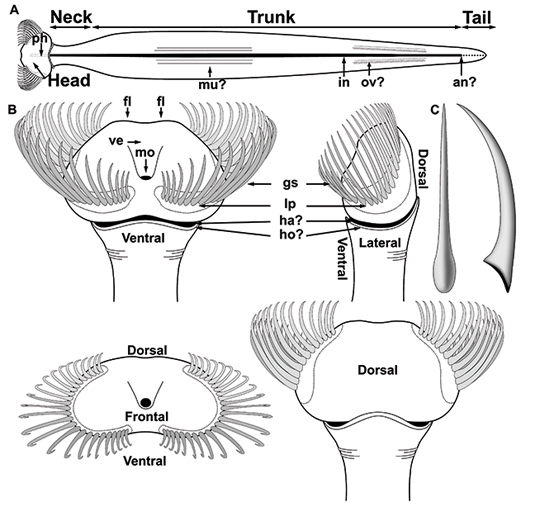New Species of Fossil Worm – the Jaws of the Cambrian
Despite the Burgess Shale fossil deposits having been studied for more than a hundred years, these ancient shales can still spring a few surprises. For example, this week saw the publication of a description of a new fossil species of arrow worm, one that at ten centimetres long, is a relative giant compared to other members of its phylum, living or extinct.
A New Species of Fossil Marine Arrow Worm Described from Burgess Shale Deposits
Picture credit: Marianne Collins
Capinatator praetermissus – Big-mouthed Predatory Marine Worm
The mysterious Chaetognatha, the bristle-jawed worms, often referred to as arrow worms, probably originated in the very Early Cambrian, but their soft bodies are rarely preserved in the fossil record.
However, a team of scientists, including Burgess Shale expert Jean-Bernard Caron (Royal Ontario Museum), have identified a new fossil species, based on around fifty specimens preserved in fine sediments in strata that make up part of the Middle Cambrian Burgess Shales (British Columbia).
The feeding apparatus comprises of up to twenty-five spines around each half of the simple mouth, nearly double the maximum number found in extant chaetognaths. the large body size and formidable-looking mouth parts suggest that these arrow worms were important predators in the Cambrian marine environment. This is one predator that could claim to be the “Jaws of the Cambrian”!
A Close-up View of the Fossilised Mouth Parts of C. praetermissus
Picture credit: JB Caron/Royal Ontario Museum
The Famous Walcott Quarry
The picture above shows a fossil specimen from the collection site – the Walcott Quarry, Burgess Shale (Yoho National Park, British Columbia, Canada). Capinatator praetermissus translates as “a swimming and grasping animal which remained overlooked for a long time”, in reference to the animal’s suggested ecological niche and the fact that despite decades of research centred around the Walcott Quarry, these fossil worms had been overlooked.
Writing in the academic journal “Current Biology”, the researchers examined numerous specimens that had soft tissue preservation. It is likely that these animals swam near the seabed and that a population was buried rapidly by a mud flow.
The bristles of these worms have a relatively high fossil preservation potential. For many years, these tough bristles were reported as conodont elements (conodonts are an extinct Class of small, jawless, marine vertebrates with pairs of robust tooth-bars that may have been used as filter-feeding apparatus), however, this research suggests that these marine worms occupied a different range of ecological niches compared to their living descendants today.
Most living members of the Chaetognatha are very small and make up a major component of marine zooplankton, but this newly named fossil species, Capinatator praetermissus was probably an active, pelagic (living above the sea floor), predator. It has also been proposed that this animal could have been benthic, living on the sea floor.
An Illustration of the Body Plan of Capinatator praetermissus
Picture credit: Marianne Collins
Studying Arrow Worms
Primitive arrow worms were much larger and had evolved a greater number of spines around their mouths compared to their modern-day counterparts. Capinatator represents one of the oldest species of arrow worm known from the fossil record. The discovery of Capinatator suggests that miniaturisation and evolving into free floating zoo plankton may have been secondary, these animals becoming smaller and changing their roles in the marine biota as other predators such as the arthropods became larger.
For an article about another Burgess Shale fossil worm discovery: Cambrian Suspension Feeder Provides Clue to Common Ancestor.
To read an article about a monster marine worm from the Devonian: Monster Worm of the Devonian.
Everything Dinosaur acknowledges the help of the Royal Ontario Museum in the compilation of this article.
The scientific paper: “A Large Cambrian Chaetognath with Supernumeracy Grasping Spines” by Derek E.G. Briggs and Jean-Bernard Caron published in the journal “Current Biology”.
Visit the Everything Dinosaur website: Everything Dinosaur.









Re Burgess shale arrow worm article:
Second paragraph, line 7. Oops! I don’t think you meant “acorn worm”, did you? These are hemichordates, such as Balanoglossus sp
Thank you for spotting that, it was a typo, should have stated arrow worm not acorn worm. Our thanks for this.